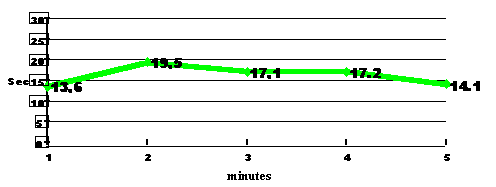Stanislaw STERKOWICZ and Pawel MASLEJAN EVALUATION OF MODERN TENDENCIES IN SOLVING JUDO FIGHT1. The Aim of StudyThe aim of the work is to try to characterize time structure of judo fight and comparing the outcome of such research with previous researches (Sikorski 1985, Sterkowicz and Kesek 1985). We tried to trace the tendencies of changes in this field and use them for practical training postulates. 2. Material and MethodsResearch material comprised 92 video-recorded fights of seniors made during the 40th Individual Polish Senior Championship in Cracow (1996) and Polish Senior Individual-Team League in Bytom-City (1996). In those tournaments took part the leading Polish judoists: P.Nastula, R.Kubacki, K.Wojdan, P.Kamrowski, J.Lewak, M.Pitula. During the above mentioned championships there were recorded the whole fights including breaks during their time, in all weight categories starting from elimination round until the final round. In working out the outcome of the research basic statistical methods were used arithmetical average±standard deviation, and the percentage role of different factors. 3. ResultsOn replaying the video of recorded fights the following results were obtained: Owing the statistical analysis we found the noteworthy characteristics of pattern senior judoists bout: You can see those results in percent on the Figure 1. Fig. 1. Percentage structure of time of judo contest The typical time structure of senior judo contest has following numerical characteristics: 4. Discussion, conclusions and final remarksOn the basis of comparing the research carried out in 1996 with the results of 1985 (Table 1).
Table 1. A comparison of chosen parameters characterizing Seniors Judo Fight in years 1983 and 1996 The following conclusions were noticed: In final remarks: From coach point of view and practice those results can be used for proper building of interval training methods, projecting special judo fitness tests etc. The next step of the research process of judo fight will be an analysis of subject or informative structure of the same 92 seniors judo contests in which we were noticed total number of 819 technical actions. We are expected significant changes manifested in the past time period by: an effectiveness of attacks in TACHI-WAZA and an asymmetry of technical schooling, i.e. left- side/right side techniques relation and in the number of hip-techniques in the total number of attacks etc. We try to verify hypothesis in the next article. 5. Bibliographical references1. Sikorski W. Aktualne problemy treningu i walki sportowej Judo. Instytut Sportu – Warszawa 1985 (In Polish). |


 Fig. 2. Time of single sequences of continuous fight and breaks in fight (average in seconds) The specific indices in consecutive minutes of the judo contests were showed on the next Figures 3-4.
Fig. 2. Time of single sequences of continuous fight and breaks in fight (average in seconds) The specific indices in consecutive minutes of the judo contests were showed on the next Figures 3-4. Fig.3. Average time of sequences of continuous fights and breaks in consecutive minutes of tournament senior judo bouts
Fig.3. Average time of sequences of continuous fights and breaks in consecutive minutes of tournament senior judo bouts Fig. 4. Average time of single sequence of fight in Ne-waza
Fig. 4. Average time of single sequence of fight in Ne-waza